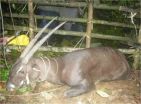(Press-News.org) For the first time in more than ten years, there has been a confirmed sighting of one of the rarest and most mysterious animals in the world, the saola of Laos and Vietnam. The Government of the Lao People's Democratic Republic (also known as Laos) announced on September15 that in late August villagers in the central province of Bolikhamxay captured a saola and brought it back to their village. The animal died several days later, but was photographed while still alive.
This is the first confirmed record of the species since two photographs of wild saola were taken in Laos in by automatic camera traps in 1999.
The saola was discovered as a species new to science only in 1992, in Vietnam's Vu Quang Nature Reserve, near the country's border with Laos. It was one of the most spectacular zoological discoveries of the 20th century. With their long horns and white facial markings, saola resemble the antelopes of North Africa, but are more closely related to wild cattle.
Saola are so secretive and so seldom seen (no biologist has ever reported seeing one in the wild) that they have been likened to unicorns (despite actually having two horns). In fact, at least one historian has speculated that a Chinese myth of a magical unicorn, the qilin, may have derived from familiarity with saola in prehistoric China (although the species does not occur there presently, if it ever did).
Today, saola occur only in dense forests of the Annamite Mountains along the Lao/Vietnamese border. The species is classed as "Critically Endangered" by the International Union for the Conservation of Nature (IUCN), and probably no more than a few hundred survive. It is one of the most threatened large mammals on the planet, and there are none in zoos anywhere in the world.
A statement issued by the Provincial Conservation Unit of Bolikhamxay Province said: "The death of this saola is unfortunate. But at least it confirms an area where it still occurs, and the government will immediately move to strengthen conservation efforts there."
When news of the saola's capture reached Lao authorities, the Bolikhamxay Provincial Agriculture and Forestry Office immediately dispatched a technical team, advised by the Lao Program of the Wildlife Conservation Society (WCS) and the IUCN Saola Working Group, to examine the saola and release it. Unfortunately, the animal, an adult male weakened by the ordeal of several days in captivity, died shortly after the team reached the remote village.
The IUCN Saola Working Group is part of the IUCN Species Survival Commission (SSC). It is a network of scientists and conservationists under the auspices of the IUCN SSC Asian Wildlife Cattle Specialist Group, and provides strategy and technical guidance for saola conservation.
William Robichaud, Coordinator of the Saola Working Group, said, "The government of Lao PDR and WCS are to be commended for their rapid response and efforts to save this animal. We hope the information gained from the incident can be used to insure that this is not the last saola anyone has a chance to see."
The animal was reportedly found in the village's sacred forest in remote Xaychamphon District, but it is not clear why the villagers took it into captivity. After its death, the technical team transported the carcass to Pakxan, the provincial capital , where biologists from WCS and the Lao government preserved all parts for analysis, future study and reference. This is the first saola specimen to be so completely preserved.
Dr. Pierre Comizzoli, a veterinarian with the Smithsonian Conservation Biology Institute and a member of the Saola Working Group, said: "Study of the carcass can yield some good from this unfortunate incident. Our lack of knowledge of saola biology is a major constraint to efforts to conserve it, and this can be a major step forward in understanding this remarkable and mysterious species".
"It's clear that further awareness-raising efforts about the special status of saola are needed," said Robichaud. "But saola doesn't have much time left - at best a few hundred survive, but it may be only a few dozen. The situation is critical."
The Lao Department of Forestry (DoF) and provincial and district authorities are moving to urge villagers in the area not to capture saola, and immediately release any they might encounter. Bouaphanh Phanthavong, Director of DoF's Division of Forest Resources Conservation (and a member of the Saola Working Group) said, "As a Party to the Convention on Biological Diversity, and as outlined in our National Biodiversity Conservation Strategy, Laos is committed to conserve biodiversity, and we want to give special attention to 'flagship species', such as the saola."
The national representative for the IUCN Lao Programme, Ms. Latsamay Sylavong, noted, "This incident highlights the importance of Laos to global wildlife conservation. Saola and several other rare endemic species are found almost nowhere else in the world. Our knowledge of them is limited, and in Laos we need to improve protection of both the ecosystems and the special species they hold, like the saola. Much needs to be done".
INFORMATION:
CONTACTS:
William Robichaud
Coordinator
IUCN SSC Saola Working Group
saolawg@gmail.com
James Burton
Chair
IUCN SSC Asian Wild Cattle Specialist Group
jburton@earthwatch.org.uk
Alex McWilliam
Site Coordinator
Integrated Ecosystem and Wildlife Management Project
Wildlife Conservation Society, Lao PDR Program
+856 20 2187184
amcwilliam@wcs.org
Michael Hedemark
Operations Manager
Wildlife Conservation Society, Lao PDR Program
+856 20 55516912
Latsamay Sylavong
National Representative
IUCN Lao Programme
latsamay.sylavong@iucn.org
Asian 'unicorn' photographed for first time in over 10 years
2010-09-17
ELSE PRESS RELEASES FROM THIS DATE:
Standardized violence-prevention programs may not prevent teen fighting, findings suggest
2010-09-17
DALLAS – Sept. 17, 2010 – UT Southwestern Medical Center investigators have uncovered new insights on adolescent fighting: what triggers it, and how to stem it.
Varied real-life factors pile on daily to put teens on edge: destructive behaviors like drug abuse, drinking or high-risk sexual encounters; poverty; academic troubles; and even depression. Data analyzed by researchers at UT Southwestern suggests that when teens perceive support from their families and/or schools, it can help mitigate violence.
"Our findings tell us that it's unlikely that traditional cookie-cutter ...
Less is more in the fight against terrorism
2010-09-17
Terrorist networks are complex. Now, a mathematical analysis of their properties published this month in the International Journal of Networking and Virtual Organisations, suggests that the best way to fight them is to isolate the hubs within the network rather than trying to destroy the network as a whole through short-term battles.
According to Philip Vos Fellman a Lecturer at Suffolk University, Boston, and member of the New England Complex Systems Institute, USA, tools used to analyze complex systems can also be used to study terrorist networks with a view to undermining ...
Research could improve detection of liver damage
2010-09-17
LIVERPOOL, UK – 17 September 2010: Research at the University of Liverpool could lead to faster and more accurate diagnoses of liver damage.
The team used paracetamol as the basis for the study: research indicates that paracetamol can place temporary stress on the liver in around a third of people who take a normal dose (4g per day) but the liver returns to normal when the drug has left the system. Overdoses of the drug are a major cause of liver failure in both the UK and US.
Scientists have discovered that the presence of specific proteins in the blood are indicative ...
Teenagers are more sedentary on weekends
2010-09-17
"A sedentary lifestyle has become one of the major public health problems in developed countries", Juan P. Rey-López, lead author of the study and a researcher at the University of Zaragoza (UNIZAR), tells SINC. "During the week, one-third of teenagers said the watched more than two hours of television per day. At weekends, this figure exceeds 60%".
The results, published in the July issue of the journal Preventive Medicine, show that teenagers devote more time to sedentary behaviour (in front of a screen) at the weekend.
The study, which forms part of the European ...
Light is the friend of lovers
2010-09-17
The increase of artificial night lighting is only one of the consequences of intense urbanization. There is no doubt that chemical and noise pollution can have a strong impact on ecosystems. To date, however, the more subtle consequences of light pollution on wild populations of animals have not received enough attention. Scientists of the Max Planck Institute for Ornithology have now shown that permanent night lighting alters the reproductive behaviour of birds. In those habitats that are affected by artificial light, males started to sing earlier and females advanced ...
At the crossroads of chromosomes
2010-09-17
PHILADELPHIA – On average, one hundred billion cells in the human body divide over the course of a day. Most of the time the body gets it right but sometimes, problems in cell replication can lead to abnormalities in chromosomes resulting in many types of disorders, from cancer to Down Syndrome.
Now, researchers at the University of Pennsylvania's School of Medicine have defined the structure of a key molecule that plays a central role in how DNA is duplicated and then moved correctly and equally into two daughter cells to produce two exact copies of the mother cell. ...
Emotional robot pets
2010-09-17
Designers of robot pets are fighting a never-ending battle with consumers to provide entertaining and realistic gadgets that respond to human interaction in ever more nuanced ways, mimicking the behavior of real pet animals or even people. Researchers in Taiwan are now looking at a new design paradigm that could see the development of a robot vision module that might one-day recognize human facial expressions and respond appropriately.
Part of the problem is that robot design takes a long time, while the consumer life cycle of any given product is very short. Moreover, ...
Physicists cross hurdle in quantum manipulation of matter
2010-09-17
Finding ways to control matter at the level of single atoms and electrons fascinates many scientists and engineers because the ability to manipulate single charges and single magnetic moments (spins) may help researchers penetrate deep into the mysteries of quantum mechanics and modern solid-state physics. It may also allow development of new, highly sensitive magnetometers with nanometer resolution, single-spin transistors for coherent spintronics, and solid-state devices for quantum information processing.
Recently, a collaboration of experimentalists from the Kavli ...
More effective weight control strategies are urgently needed
2010-09-17
New Rochelle, NY, September 17, 2010—September is National Childhood Obesity Awareness Month, drawing attention to the epidemic of obesity among children and adolescents in the United States. A multidisciplinary approach to assessment and intervention is crucial for effective weight management and should draw from the latest medical evidence, best practices, and innovative educational and policy initiatives, all of which are presented and debated in the new bimonthly, print and online journal Childhood Obesity, published by Mary Ann Liebert, Inc. The inaugural issue is ...
When the Earth mantle finds its core
2010-09-17
The Earth's mantle and its core mix at a distance of 2900 km under our feet in a mysterious zone. A team of geophysicists has just verified that the partial fusion of the mantle is possible in this area when the temperature reaches 4200 Kelvin. This reinforces the hypothesis of the presence of a deep magma ocean. The originality of this work, carried out by the scientists of the Institut de minéralogie et de physique des milieux condensés (UPMC/Université Paris Diderot/Institut de Physique du Globe/CNRS/IRD), lies in the use of X-ray diffraction at the European Synchrotron ...





